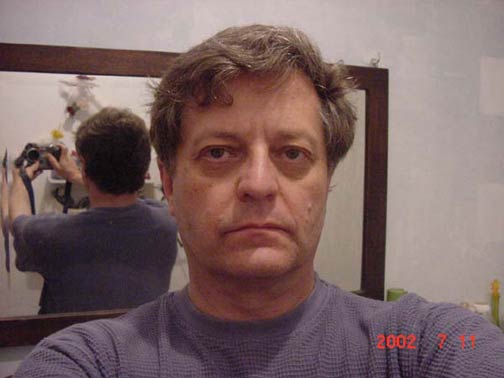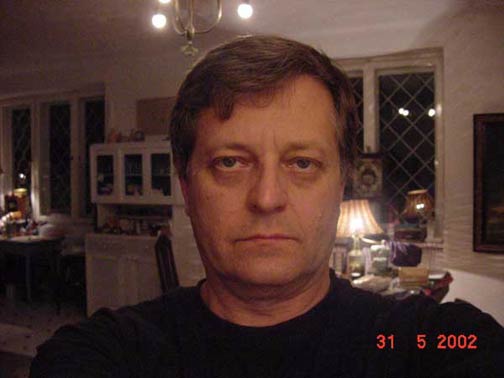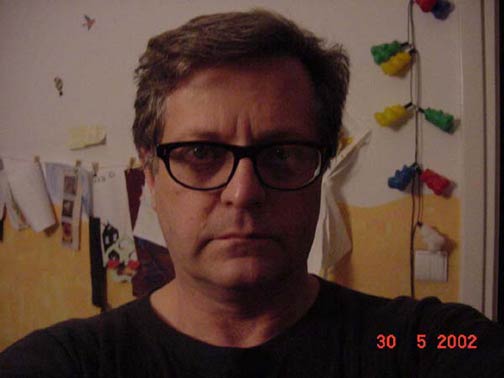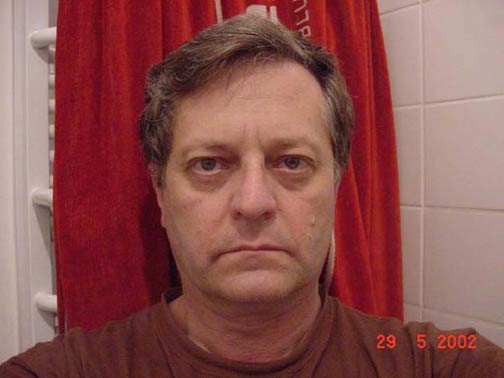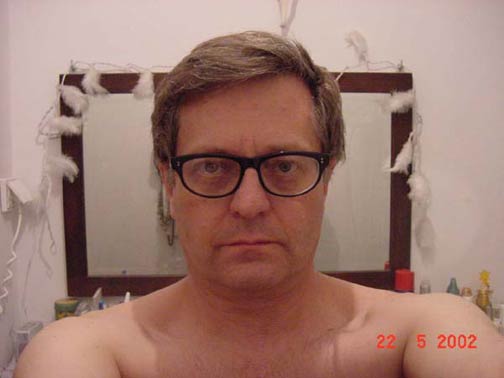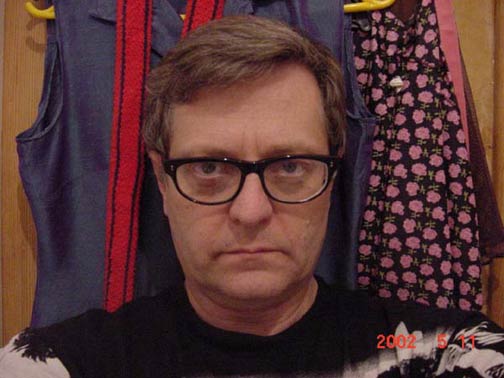Mala Gallery
8, Zamkowy Sq., Warsaw (Old Town)
September 10 - October 4, 2002
Jozef Zuk Piwkowski: Photomemory
Józef Żuk Piwkowski: Zapis - Photomemory, Mała Galeria ZPAF-CSW, Warszawa, wrzesień 2002
HE idea to register oneself or a fragment of one's own personality by photographing his or her own face was pursued by artists many times. The value of Zuk Piwkowski's experiment consists not only of the fact that it lasts already 25 years. It is also a project that takes into consideration technological development of image recording. The artist started to register his self-portraits in analogous system of conventional photography and continued this project - after a quite long time considering the rapid development of digital imaging - using the most advanced means of electronic recording.
Aside from the merits of this project resulting from the mere fact of its continuity, an interesting aspect of this artistic undertaking seems to be an attempt to pass fluently to the area of another technology and the resulting from this consequences of aesthetic nature. A question arises: did the artist do that for purely practical purposes relying unconditionally upon new media or was it a deliberate measure taken to point at the differences and limitations or - on the contrary - the reason for that was widening of the area of artistic experiment.
It does not seem like the sole reason were facilitation resulting from the use of more advanced and developed system. This confrontation of the two possibilities - still possible because occurring before our eyes - is the most interesting element of this work. Some years from now probably it will not be possible to come back to analogous recording of such project, what will be the result not only of conscious choice of a certain image recording system, but the technology itself will coerce on us the use of digital recording - and no one will bother to repeat such an action, since in this case it would be only a sentimental journey towards history of Photography*.
Marek Grygiel
* This word with capital P should still appear here
Jozef Zuk Piwkowski: Photomemory, exhibition in Mala Gallery, Warsaw, September 2002
A Sketch for a Group Self-Portrait
by Janusz Zagrodzki
ISTORY is full of events whose significance is far beyond the possibility of empirical verification, making hard work for interpreters; the more so - the more surprising the nature of the actions involved. It is those inexplicable situations that exert the greatest influence on the shaping of human consciousness. If they take on the form of meaningful messages sometimes referred to as works of art, they broaden our views on the space and time in which we live and bring us closer to the hitherto unexplained causes of our existence.
It is a rule in art that a work, its form or the field of its impact, draws its real boundaries, or, which we can confirm empirically, the range of its meanings. To appreciate the significance of this statement one must realize again and again that a work of art only acquires its status as a transmission of certain values if its presence moves the audience's consciousness or creates a need for an exchange of thoughts. Applying ever more advanced technologies, artists evoke selected objects and images, combine and contrast unattached episodes taken from life or from their imaginings, stake out the world according to their individual order and principles. It is sometimes difficult to find logical premises to their actions. The same works may appear simplistic to some, while to others they seem overly complicated, inaccessible, intriguing but unclear. Still, a graspable explanation of the qualities of a given work of art usually is usually possible, and pieces using extremely diverse means of expression and relating to divergent issues display an unseen internal regularity. One way of discovering the structure of works recorded on photosensitive film, on analogue or digital data carriers is to break them up into elementary parts. Determining the internal structure of a recorded event, the spatial characteristics of each frame, explaining the origin of seemingly contradictory stories and actions is at the core of the work of Jozef Zuk Piwkowski, engineer and filmmaker, who in his nearly 25 years of artistic activity has used virtually all existing methods of recording images, from photography and film through computer graphics to latest-generation electronics.
A common feature of all of Piwkowski's work is a consistent, almost mathematical structure and a witty concept. For instance, in Pierwszy Film (The First Film, 1981) he analyses the Lumičre brothers' Workers Leaving A Factory in Lyon (1894), follows the different possible close-ups, develops scenes whose fragments were used in editing the film, achieving a complete deconstruction of the message. Księga słów wszystkich (A Book of All Words), possibly Piwkowski's best-known work, is a fully structural computer creation, suspended in infinity, accessed through freely selected individual pages. This project, connected with the international Art & Communication exhibition, which was to be held simultaneously at the Museum of Modern Art in Lodz and the Massachusetts Institute of Technology in 1987, unrealized because of the imperfect means of communication available at the time, was first shown during the International Book Fair in Frankfurt in 2000.
Among the wide array of activities undertaken by Piwkowski since the start of his artistic route particularly notable is the series of self-portraits, begun as long ago as 1977 and serving as a personal calendar, which later expanded into a diary of everyday events relevant to the artist. At first each portrait was treated as a small element of a gradually emerging structure in which photographs of his face marked the passing of time. Recorded excerpts from life, placed on the Internet, extend the original idea. Personal situations, scraps of everyday reality are used to build an open structure of life seen in both micro- and macroscopic scale. The tendency towards self-glorification and idealization, typical of self-portraits, is replaced with self-irony, as in the artistic autobiography quoted after the film Rejs (The Cruise). Distorting mirror images, grotesque and caricature, the gift of noticing one's own defects, humour - especially valuable when directed at oneself – are also present. The way an artist presents himself is a complex product of personal traits, self-awareness, compromise, hopes and potential, which becomes convincing only when he knows how to laugh at his own vices. The perception of oneself is an amplified expression of one's attitudes to other people, social groups, nations, and, finally, humanity as a whole. Piwkowski's self-portraits can be treated as part of another of his artistic projects, Portert zbiorowy Polaków (Poles: a Group Portrait) , the idea for which goes back nearly to the beginning of John Paul II's pontificate, after his first pilgrimage to Poland was announced. At that time, lack of adequate technology prevented its realization. A group portrait or self-portrait understood in such a way enters into the domain of psychology and sociology, revealing different models of creation, forming a structurally rich image of human beings. A self-portrait, prepared and directed, is the record of a certain strategy. Through the language he uses the artist reveals himself, communicates his view of acceptable situations constituting a framework for human actions. However, the effect is different if, as Piwkowski suggested, the self-portraits are filmed on the specially chosen dates from August 16 to 19, 2002, when the individual co-authors were able to come into touch with the person-symbol, the man-idea, John Paul II. Recording an image of society in connection with an event chosen from the broad space of our lives, defined in terms of time and place, with its exceptionally wide impact, evokes particular kinds of behaviour. A self-portrait thus understood involves a moral message, received through the media in nearly all homes, as we simultaneously sit down at a table with the Pope present in a central place. Piwkowski hints at correlations between the teaching of John Paul II and the artist's psyche, showing them through the choice of place and surroundings – home, studio, the outdoors; of those present – family, friends; of selected props defining our personalities.
Zuk Piwkowski's group self-portrait is an attempt at materializing an imagined space of infinite possibilities, filled with human beings, without beginning or end, but real, perceptible with the senses, visible, audible and tangible, digitally made permanent in a network of innumerable computers, a space of events which we can access at any moment; which can be compared to a table with countless seats , standing simultaneously in all personal dimensions of all people – participants and observers of the same event. The light flowing from the screen, the space in which Pope John Paul II is present, becomes a place where hundreds, thousands, millions of human beings are congregated, united in this extraordinarily important moment. Piwkowski confirms their presence and their behaviour at the time by summoning and receiving Internet transmissions. Switching on the screen, accessing the transmission which established links among innumerable people obliterates the boundary between observer and observed and becomes at the same time an act of releasing a symbolic shutter, registering a group portrait including even those who did not have their pictures filmed but who were there, participated in the event and recorded the image in the zillion cells of human memory, thus becoming an integral part of it.
Janusz Zagrodzki
See also:
Jozef Zuk Piwkowski: Photomemory, exhibition in Mala Gallery, Warsaw, September 2002
back to FOTOTAPETA's front page
Copyright © 1997-2026 Marek Grygiel / Copyright for www edition © 1997-2026 Zeta-Media Inc.
04 - 10 - 2002
